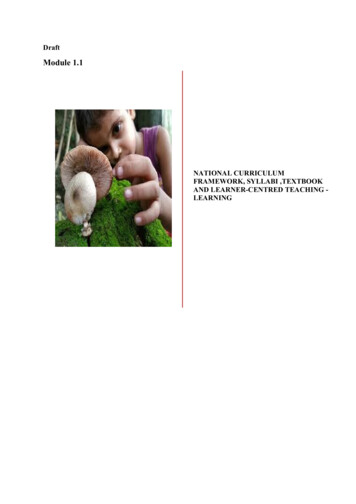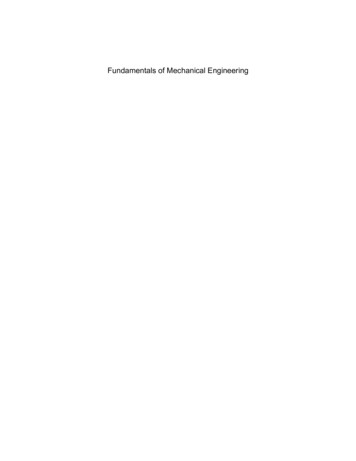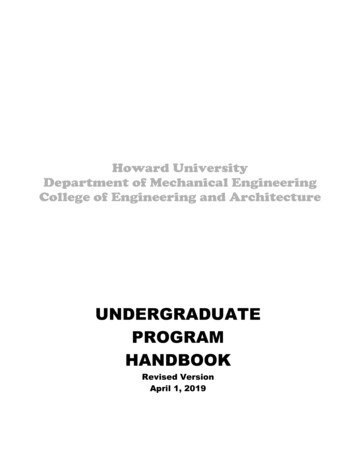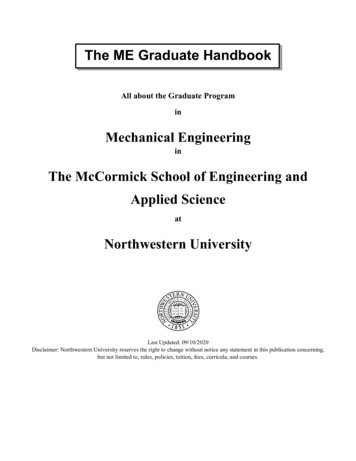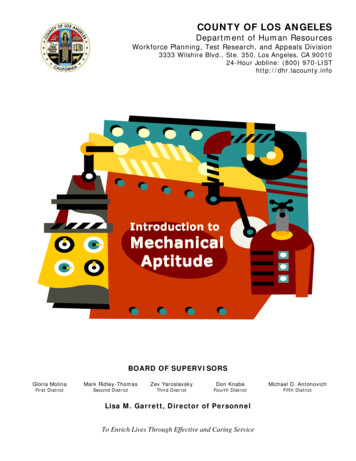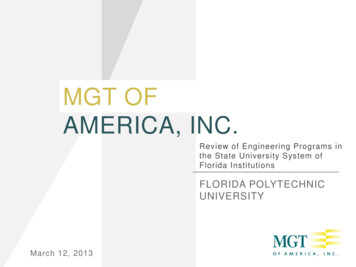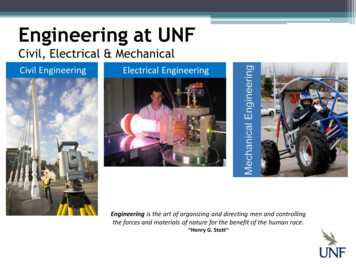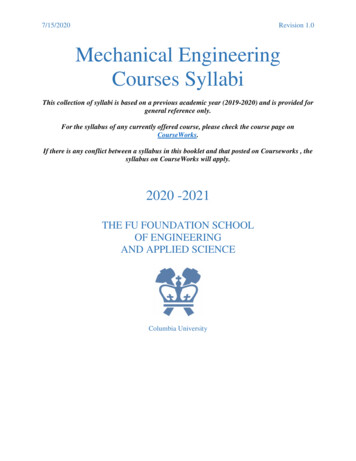
Transcription
7/15/2020Revision 1.0Mechanical EngineeringCourses SyllabiThis collection of syllabi is based on a previous academic year (2019-2020) and is provided forgeneral reference only.For the syllabus of any currently offered course, please check the course page onCourseWorks.If there is any conflict between a syllabus in this booklet and that posted on Courseworks , thesyllabus on CourseWorks will apply.2020 -2021THE FU FOUNDATION SCHOOLOF ENGINEERINGAND APPLIED SCIENCEColumbia University
Syllabi Table of ContentsEEME E4601: Digital Control SystemsEEME E6601: Introduction to Control TheoryMEBM E4439: Modeling and Identification of Dynamic SystemsMEBM E4710: Morphogenesis: shape and structure in biological materialsMEBM E6310: Mixt IXT THEORIES FOR BIOL TISSUESMECS 4510: Evolutionary Computation and Design AutomationMECS 6616: Robot LearningME E4058: Mechatronics & Embedded Microcomputer ControlMECE E4100 Mechanics of Fluids Course Meeting TimesMECE E4210: Energy Infrastructure PlanningMECE E4212: Microelectromechanical SystemsMECE E4213: Bio-Microelectromechanical Systems (BioMEMS)MECE E4302: Advanced ThermodynamicsMECE E4305: Mechanics and Thermodynamics of PropulsionMECE4306: Introduction to AerodynamicsMECE E4312: Solar Thermal EngineeringMECE E4314: Energy Dynamics of Green BuildingsMECH E4320: Introduction to CombustionMECE E4330: Thermofluid Systems DesignMECE 4431: Space Vehicle DynamicsMECE-E4520: Data Science for Mechanical SystemsMECE-E4603: Applied Robotics: Algorithms and SoftwareMECE E4604: Product Design for ManufacturingMECE 4606: Digital ManufacturingMECE E4609: Computer Aided ManufacturingMECE E4610: Advanced Manufacturing ProcessesMECE E4611: Robotics StudioMECE E4811: Aerospace Human Factors EngineeringMECE E4999: FieldworkMECE E6100: Advanced Mechanics of FluidsMECE E6102: Computational Heat Transfer and Fluid FlowMECE E6104: Case Studies in Computational Fluid DynamicsMECE E6313: Advanced Heat TransferMECE E6400: Advanced Machine DynamicsMECE E6422: Intro-Theory of ElasticityMECE E6423: Introduction to the Theory of Elasticity IIMEEM E6432: Small Scale Mechanical BehaviorMECE E6617: Advanced Kinematics, Dynamics, and Control in RoboticsMECE E6620: Applied Signal Recognition and ClassificationMEIE E4810: Intro to Human Space FlightMEMS Production and Packaging-2-
EEME E4601 Digital Control Systems SyllabusProfessor: Professor Richard LongmanPrimary contact: Email RWL4@columbia.edu1. Course Description:This course in digital control systems emphasizes all of the extra difficulties and considerations that are introduced by makinguse of a digital controller. Digital controllers necessarily sample the error signal at sample times and updates the control action atthe next sample. This introduces many issues about how to create input-output models in terms of difference equations, theinfluence of sampling on stability, and on signal fidelity including aliasing/folding, choice of sample rate, etc. Both classicalcontrol approaches and modern or state variable control approaches are treated. To have a complete picture of the design processit is best to take EEME E6601 or EEME E3601. These courses can be taken either before or after taking digital control, butbefore is preferable.2. Prerequisites:The main basis for the mathematics used is ordinary differential equation, and there is some use of linear algebra. Material in thecourse is intended to refresh your memory on these topics.3. Required Textbook: Kuo, Benjamin C., Digital Control Systems, 2nd edition, Oxford University Press ISBM 0-1951-2064-7Topics from throughout the book are covered, but the lecture topics can come from many places through the book in any order.Some homework assignments are from the book.There are also a number of handouts specifically prepared for the class on various useful topics.5. Grading: One Midterm Exam 45%, Final (cumulative) Exam 45%, Homework 10%.6. Assignments: Approximately weekly homework assignments. These are important, you need to struggle with the material inorder to digest it, and also to be able prepared for the exams.7. Exam Schedule:There are weekly 3-hour lectures. The midterm exam is usually given after the 8th lecture or the 7th lecture. Midterm exam is 3hours.Final exam (cumulative) is normally scheduled after all lectures have been viewed, usually scheduled by the registrar.EEME E4601 Digital Control Systems Professor LongmanLECTURE TOPICS, RELATED HANDOUTS, RELATED BOOK SECTIONS, HOMEWORK AND EXAM TIMINGText: Kuo, Benjamin C., Digital Control Systems, 2nd edition, Oxford University Press ISBM 0-1951-2064-7Lecture 1: Introduction to feedback and digital feedback control. Block diagrams of different digital control systems. Conversionof classical feedback control laws to digital control lawsHandout: 4601ZOHandQuantizationHandout.pdf (From textbook) Book: Chapter 1 IntroChapter 2 pages 13-28, 55-67 (contains extra information)Lecture 2: Solution of homogeneous ordinary differential equations (ODE), and difference equations. How to make ahomogeneous difference equation whose solution is the same at sample times as the differential equation. Digital controllers asdifference equations, solution of homogeneous difference equations. Desired properties of the solution, time constants, settlingtime, stability.Handout: 4601SolveHomogeneousODE.pdf Homework 1Lecture 3: Forced response of difference equations. Particular solutions of ODE and difference equations. Laplace transferfunctions, ODE and transfer functions conversion, and block diagrams. Z-Transforms and z-transfer functions, conversions,block diagrams, z-transfer functions of discrete PID controllers. Particular solutions of difference equations.Handout: pdf (from book)Lecture 4: More discussion of solutions of ODE and difference equations, both homogeneous and particular. Block diagramalgebra when all blocks are z-transfer functions. Laplace transforms, solution of difference equations using z-transforms. A rootlocus plot tuning the controller gain. Interpretation: for stability and settling time.Book: Chapter 3.1, 3.2, 3.4; Chapter 4, pp. 124-129Chapter 3.5-3.7 on z-transforms Homework 2Lecture 5: Block diagram manipulation, converting a differential equation (e.g. the plant) fed by a zero-order hold, to aequivalent difference equation, finding system response using z-transfer functions. Rule 1 and Rule 2. Use of transform table toconvert ODE to difference equations, and make block diagram contain only samples-3-
signals – eliminating A/D and D/A. Block diagram algebra to get closed loop difference equation. Partial fraction expansions.Handout and Book: 4601zTransformTable.pdf (again) Book: Chapter 4.3-4.4Lecture 6: More discussion: Converting continuous elements following zero order holds to digital form. Block diagrammanipulation for different cases. Finding closed loop difference equation. Aliasing.Handout: 4601AliasingFigures.pdf Homework 3MIDTERM EXAMHandout: 4601WhatToKnowForMidtermAndFinal.pdfLecture 7: Design process: choice of controller, conversion to digital plant, finding closed loop difference equation. Three partsto the solutions: solution of homogeneous equation, particular solution for commands, particular solution for disturbances. Whatdo you want each part of the solution to look like? Settling time seen in unit circle. Visualize solution for poles in variouslocations. Jury test for stability. Bilinear transformation and Routh criterion for stability.Book: Chapter 3.3, 6.7.1, 6.7.2Lecture 8: Derivation of transforms for holds. Develop Rule 1 using superposition and convolution sum. Develop Rule 3 toevaluate what happens between sample times.Homework 4Lecture 9: State space models of scalar ordinary differential equations. Solutions. Conversion to state space difference equations.Rule 1 for state space models. Derivations of entries in Table 5-1.Handout: 4601Table 5 1TextStateSpaceEquations.pdf Book: Chapter 5.1 -5.9, 5.11, 5.12Lecture 10: State transition matrix (exponential of a matrix) for differential and difference equations. Response between sampletimes. Stability of state space difference equations. Diagonalization of matrices. Rule 3 for state space models. Identification ofdifference equation models from input-output data.Chapter 5.17, 5.18 Homework 5Lecture 11: System identification. Frequency response. Nyquist. Root Locus for difference equations.Lecture 12: Controllability, observability. Luenberger observers. State feedback and pole placement. Linear QuadraticRegulator.Lecture 13: Bode plots, w-plane, Nyquist contour, Nyquist stability criterion. Folding. LMPC linear model predictive control.Book: See Nyquist in textFINAL EXAM Handout: 4601WhatToKnowForMidtermAndFinal.pdf-4-
EEME E6601 Introduction to Control Theory SyllabusProfessor: Professor Richard LongmanPrimary contact: Email RWL4@columbia.edu1. Course Description:This is a self-contained graduate level introduction to linear feedback control systems. It does not assume any previouscourse in control. The course covers both classical control design methods, and modern or state variable controlmethods for designing automatic control systems. It is appropriate to take this course even if you already have seemclassical control in another course, because it covers a much broader set of material, and does so on a 6000 levelexpecting more sophistication of understanding.2. Prerequisites:The course makes substantial use of ordinary equations, matrix differential equation, linear algebra, similaritytransformations, Laplace transforms. The course is self-contained with respect to these topics, presenting what youneed to know or need to remember in these fields, but previous familiarity with these topics is very helpful.3. MS/PhD ProgramsControl systems and control system concepts are used in many fields, so the course can be relevant to students in manydepartments. The course designator EEME indicated that it is particularly appropriate for people in ElectricalEngineering and in Mechanical Engineering, including the fields that merge the two, Mechatronics and Robotics.Feedback control is fundamental to Aeronautics and to Astronautics, to Chemical Process Control, to NuclearEngineering, Automotive Engineering, and gets used in various ways in Civil Engineering for structural control andstructural health monitoring. It also gets used beyond engineering, in Business and in Economics – aiming to optimallymanage economic growth of an economy.4. Required Textbook:Required Textbook, Modern Control Engineering, by Ogata, 5th Edition, ISBN- 13: 978- 0136156734.Topics from throughout the book are covered, but the lecture topics can come from many places through the book inany order. Some homework assignments are from the book.There are also a number of handouts specifically prepared for the class on various useful topics.5. Grading:One Midterm ExamFinal (cumulative) ExamHomework45%,45%,10%.6. Assignments:Approximately weekly homework assignments. These are important, you need to struggle with the material in order todigest it, and also to be able prepared for the exams.7. Exam Schedule:There are weekly 3-hour lectures. The midterm exam is usually given after the 8th lecture or the 7th lecture. Midtermexam is 3 hours.Final exam is normally scheduled after all lectures have been viewed, usually scheduled by the registrar.EEME E6601 Schedule of Lectures, Homework Assignments, and ExamsThe following list of topics is a representative list, but topics can be different or in a different order for any given year. Andhomework assignments may be different and due at different times.LECTURE 1:Classical control feedback loop, scalar differential equation models, Laplace transforms and transfer functions, statevariable models, state observers, and modern control feedback structure. Related Handouts BasicStructure ControlDesignAndODE LaplaceTransforms HomeworkHomework #1 Relates to this lecture Due at Lecture 4-5-
LECTURE 2:Response to command, to disturbances, to initial conditions. Solution of homogeneous differential equations. Stability,time constants, settling time, overshoot, desired pole locations for good performance. Solution of homogeneous statespace equations. Related Handouts TransFnsAndBlockDiag HomogEqSol HomogEqSolAsTransients HomeworkHomework #2 Relates to this lecture Due at Lecture 4LECTURE 3:Particular solutions. Annihilator method. Effect of controller gains on particular solutions. Impulse response, unit stepresponse. Number of zeros vs. number of poles. Related Handouts ParticularSolutions HomeworkHomework #3 Relates to this lecture Due at Lecture 5LECTURE 4:State variable models, multi-input, multi-output. Controllable and observable canonical form. Similaritytransformations and conversions of state variables. Numerical solution of ODE’s. HomeworkHomework #4 Relates to this lecture Due at Lecture 6 Homeworks 1 and 2 dueLECTURE 5:Response of classical control laws to commands, disturbances, and initialconditions. Related Handout RoutineControlLaws HomeworkHomework #5 Relates to this lecture Due at Lecture 7 Homework 3 dueLECTURE 6:Routh Criterion with special rules, use for range of stable gains, for gains producing desired settling times. Poleplacement controller design for state variable models. No Handouts – Refer to Text HomeworkHomework 4 dueLECTURE 7:Observable canonical form and designing Luenberger observers by pole placement. Converting observable tocontrollable form. The separation theorem for controller and observer design, and closed loop stability. The Kalmanfilter observer. Related Handout QuadraticCostKalman HomeworkHomework #6 assigned Due at Lecture 8 (one week) Homework 5 dueLECTURE 8:Kalman filter. Exponential of a matrix, the state transition matrix. Diagonalization. Homework 4assignedMIDTERM EXAM(3 hours, closed book. Laplace tables supplied in case wanted) Related Handout WhatToKnowForMidtermLECTURE 9:Generalized eigenvectors. Jordan canonical form and exponential of matrix. Nilpotent matrix. Root locus plots forvarying one parameter. Related Handouts RootLocusLECTURE 10:Root locus rules. Tuning more than one gain with root locus. Root locus vs. pole placement. Related Handouts RootLocusLECTURE 11:More root locus rules. Root finding. Frequency response. Related Handouts RootLocus FrequencyResponse HomeworkHomework #7 due at Lecture 13LECTURE 12:-6-
Nyquist and Bode plots of frequency response. Bode plot superposition and linear approzimations. Use for response tocommand and bandwidth, for response to disturbances. Nyquist stability criterion. Gain and phase margin measures ofdegree of stability. HomeworkHomework 8, do not need to turn inLECTURE 13:Controllability. Rank of square and rectangular matrices. Observability. Controller design by Linear QuadraticRegulator. Related Handouts QuadraticCostPagesFromOgata QuadraticCostKalman HomeworkHomework #7 DueFINAL EXAM(3 hours, closed book. Laplace tables supplied in case wanted) Scheduled by Columbia Registrar Related Handout WhatToKnowForFinal-7-
MEBM E4439 – Modeling and Identification of Dynamic SystemsProfessor: Nicolas W. Chbat, PhDTeaching Assistant: Cheng BiWeekTopicHours12Fluid Systems, Physical LawsGeneralized Dynamics System Modeling, Linear Systems,Convolution, Impulse and Step Responses, State-SpaceMatlab/SIMULINK*Nonlinearities, 3rd and higher order systemsThermal Systems, Mechanical SystemsMechanical Systems (cont’d)Electrical and Diffusive SystemsHybrid Systems, Transformers, GyratorsClassical & Non-parametric System Identification, Z-transformStochastic signals, Parametric System IdentificationKalman Filter, Observer-Kalman Identification (OKID)Lab session: Matlab’s System ID Toolbox*, Review33345678, 910, 1112, 13ExtraGrade:Homework:Exam 1:Exam 2:Total:33333666240%25%35%100%There will be 10 homework sets and 2 exams. Exam1 is a modeling project.Textbooks (suggested – also on reserve in library):1. Rowell, Wormley System Dynamics, An Introduction2. Chow, Frederick, Chbat Discrete-Time Control Problems using Matlab3. DiStefano III Dynamic System Biology Modeling and Simulation4. Iserman, Munchhof Identification of Dynamic Systems, Introduction with ApplicationsRationale: Articulating real-world dynamics mathematically, i.e. modeling, is often half of the battle in solving engineeringproblems. Understanding different modeling approaches (based on data, rules, physics, or probabilities) and their applicability isan invaluable tool to the practicing engineer. Quickly obtaining ordinary differential equations of a dynamic system andestimating its parameters from experimental data (system id or parameter estimation), sets the engineer apart. A model thusobtained can be readily used for prediction, diagnosis, or controller design.-8-
MEBM E4710 Morphogenesis: Shape and Structure in Biological MaterialsOffice Hours Prof. Kasza: TBA, Mudd 220C (and by appointment, karen.kasza@columbia.edu)PrerequisitesCourses in mechanics, thermodynamics, and ordinary differential equations (for example ENME 3113, MECE E3301,and MATH UN3027) at the undergraduate level or instructor's permission.Description Introduction to how shape and structure are generated in biological materials using an engineering approach thatemphasizes the application of fundamental physical concepts to a diverse set of problems. Mechanisms of pattern formation, selfassembly, and self- organization in biological materials, including intracellular structures, cells, tissues, and developing embryos.Structure, mechanical properties, and dynamic behavior of these materials. Course uses textbook materials as well as a collectionof research papers.Textbooks For course readings, I am requiring: Mechanisms of Morphogenesis, 2nd Edition, Jamie Davies (required)Other texts that may be helpful: Biological Physics of the Developing Embryo, 1st Ed., by Forgacs and Newman, Cambridge University Press, 2005. Molecular Biology of the Cell, 6th Ed., by Alberts et al., Garland, 2014. Physical Biology of the Cell, 2nd Ed., by Phillips, Kondev, Theriot, and Garcia, Garland Science, 2012. Mechanics of Motor Proteins and the Cytoskeleton, by Jonathan Howard, Sinauer, 2001.Course structureThe course will consist of lectures and in-class discussions of research papers. For in- class discussions, you shouldread the papers well ahead of time and prepare a "reading memo" that will help you prepare for the discussion (detailsto follow).HomeworkHomework and paper readings will be assigned every one or two weeks.Homework and reading memos must be submitted electronically via Courseworks as a pdf file.You are encouraged to discuss with the TA and the instructor. You may discuss with classmates, but the work yousubmit should be your own. Copying homework from other students is unacceptable, against University regulations,and will be dealt with according to University policy. You may not consult solutions from past years, online, orfrom textbook solutions.Final presentation Each student will read and present a research paper to the class. I will post suggested papers. You areencouraged to use one of these papers for your presentation, but if you have another paper you would like to present, you maypropose it to me for approval.Phones Cell phone use is not allowed during class.Grading 35% Homework 25% Reading memos 15% Participation in in-class discussions 25% Final presentationImportant Note I would like to notify all individuals with access to the MEBM E4710 course materials that the course materialis copyrighted and is not to be freely distributed/posted online without the written consent of the professor. I explicitly denyconsent to the posting of the lecture slides, exams, assignments and answers to any assignment or exam on any website outside ofColumbia University's Canvas (a.k.a Courseworks2). Notice has been provided directly to Course Hero that they are not to acceptany course content from this course for the current and for the past semesters. Providing and posting such content is in violationof the Digital Millennium Copyright Act.-9-
MEBM E6310 MIXT THEORIES FOR BIOL TISSUESNotice:I would like to notify all individuals with access to the MEBM E6310 course material that the course material forMEBM E6310 is copyrighted and is not to be freely distributed/posted online without the written consent of theprofessor. I explicitly deny consent to the posting of the lecture slides, exams, assignments and answers to anyassignment or exam on any website outside of Columbia University's Courseworks. Providing and posting such contentis in violation of the Digital Millennium Copyright Act.Academic IntegrityThe follow constitutes cheating: Copying assignments from others. Consulting solutions sets and laboratory reports from previous years. Consulting exams from previous years that were not made available by instructor. Completing individual assignments in a group, when permission not explicitly granted by instructor. Plagiarizing the work of others. Cheating may lead to the following consequences: Student receives a failing grade for a specific assignment. Student receives a failing grade for an entire course. Student may be expelled from the university. The Department of Mechanical Engineering adheres to Columbia's policies on academic integrity, rity.Student Bill of Rights Academic integrity policies clearly explained at start of semester Course requirements/grading policies/etc. must be clearly stated at start of semester. Textbook/reference book usage must be clarified at start of semester. Homework assignments will be graded on a weekly basis (unless valid explanation provided). Midterm exams will be graded within two weeks of test (unless valid explanation provided). Final exams will be graded within the deadlines set by the university. Instructor and teaching assistants must provide office hours or otherwise explain procedure for meeting with students. Instructors will provide pertinent information on assignments and lab reports in a timely manner.Honor Code Honor code: https://www.cc-seas.columbia.edu/integrity (https://www.cc-seas.columbia.edu/integrity) Also review the guidelines posted scipline.pdf) All coursework is to be done by the student working alone. For homework assignments, you may consult other studentsfor general guidelines or to review and discuss material covered in class, but homework assignments must becompleted individually. No external aids or electronic devices are allowed in exams. Do not look up homework solution sets posted from previous years or posted elsewhere. Consult the instructor if you require clarifications regarding the honor code.Course Grading Homeworks 30% Midterm Exam 30% Final Exam 40%Chapter 1: Mixture Theory Historyo The theory of mixtureo Mixture theory for biological tissues Basic definitions in mixture theoryo Apparent and true mass densitieso Molar concentration Simplifying assumptions for biological tissueso Intrinsic incompressibility of constituents- 10 -
ooooElectroneutralityIsothermal conditionsConstrained mixtures of solid constituentsNegligible fluid viscosity and solid viscoelasticityChapter 2: Tissues Modeled as a Mixture of a Solid and a Fluid Introduction Governing equations of a solid-fluid (biphasic) mixtureo Overviewo Mass balanceo Stress tensor of mixture constituento Momentum balanceo Energy balanceo Entropy inequalityo Kinematics of the continuumo Constitutive assumptionso Implications for momentum balanceo Frictional drag between fluid and solid constituentso Linear isotropic elastic solido Summary of governing equations Boundary conditionso Mass jump across an interfaceo Momentum jump across an interfaceo Energy jump across an interfaceo Summary of boundary conditions Permeationo Steady-state permeationo Transient response Confined compressiono Creepo Stress-relaxation Unconfined compressiono Solution by the method of Laplace transform Initial and equilibrium responses Transient response Transport across thin membranesChapter 3: Solute Transport in Biological Tissues Introduction Governing equations for a solid-solvent-solute mixtureo Constitutive assumptionso Implications for momentum balanceo Frictional drago Chemical potential of ideal solutions Fluid mixtures Solid-fluid mixtureso Chemical potential of non-ideal solutionso Solubility and partition coefficiento Diffusion coefficients and Fick's laws for dilute solutions Summary of governing equations Boundary conditions FEBio tutorialCourse Summary:DateDetailsWed Jan 29, 2020HW 01 signments/404587Wed Feb 5, 2020HW 02 signments/408288Wed Feb 19, 2020HW 03 signments/413051Wed Feb 26, 2020HW 04 signments/415759Wed March 4, 2020 HW 05 signments/417622Time4:10 pm4:10 pm4:10 pm4:10 pm4:10 pm- 11 -
Wed Apr 1, 2020Wed Apr 15, 2020Wed May 13, 2020MidtermExamination signments/421604HW 06 signments/432255Final es/95904/assignments/4430297 pm4:10 pm4:10 pm- 12 -
MECS 4510 – Evolutionary Computation and Design Automation1. Credits: 32. Contact Hours: 2.5 hours/week3. Instructor’s or course coordinator’s name: Hod Lipson4. Textbook Information: Melanie Mitchell, (1996) An introduction to genetic algorithms,MIT Pressa. Other Supplemental Materials: Lecture slides5. Specific Course Informationa. Course Description: Covers fundamental and advanced topics in evolutionary algorithms and their application toopen-ended optimization and computational design. Covers genetic algorithms, genetic programming, and evolutionarystrategies, as well as governing dynamics of co-evolution and symbiosis. Includes discussions of problemrepresentations and applications to design problems in a variety of domains including software, electronics, andmechanics.b. Prerequisites: Programming Experiencec. Co-requisites: N/Ad. Course Required or Elective: Elective6. Specific Goals for the Coursea. Specific Outcomes of Instruction: The student will be able to understand and apply evolutionary computationtechniques to solve global optimization problems in engineering design.b. Student Outcomes Addressed by Course: a, b, c, e, k, m7. Brief list of topics to be covered1.Optimization background and terminology: Gradient optimization methods, sampling methods, linearprogramming, combinatorial optimization.2.Evolutionary Biology background and terminology: Genotype and phenotype, unit of selection, genes andtraits, chromosomes, alleles, diploid and haploid, fitness, mutation and recombination. Selection, variationand landscapes. The strengths and weaknesses of the evolutionary model. Inductive bias. The “No free lunch”theorem.3.Genetic Algorithms: Representation, operators, and standard algorithm. The building block hypothesis andthe schema theorem.4.Evolutionary strategies: Evolution in continuous variables. Transformations.5.Genetic Programming. Building blocks and architecture-altering operators. Libraries and Trees.6.Selection mechanisms: Fitness proportionate, rank, tournament, Stochastic Universal Sampling and Boltzmanselection methods. Niching methods. Spatial methods. Consequences of selection models.7.Artificial landscapes and test functions: The Two-armed bandit problem. Multimodal and deceptive functions. Royal roads. N-k landscapes. Hierarchical and fractal functions. Paretoevolution.8.Co-evolution: Multiple populations and single-population co-evolution, relative and absolute fitness,engagement and gradient loss, the red queen effect. The credit assignment problem.9.Evolutionary dynamics and game-theoretic models: Evolutionary stable states, cycles and chaos. The iteratedprisoner’s dilemma. Evolution of cooperation.10.Evolution and learning: Plasticity and life-time learning. Lamarckian learning, how learning can guideevolution. The Baldwin effect.11.Symbiosis as a source of evolutionary innovation. Macro-mutations, Major transitions in evolution,symbiosis and symbiogenesis. How symbiosis can guide evolution.12.Evolutionary algorithms as models: Modeling sexual selection, modeling ecosystems, artificial life.13.Evolutionary robotics and evolutionary hardware: Evolving control. Evolving morphology. Body-brain coevolution. Evolution in simulation and in reality. The case for and against simulation.14.Modularity and regularity in evolution. The scaling problem and the curse of dimensionality. Evolvability.Module acquisition. Developmental models. Compositional and hierarchical approaches.15.Swarm intelligence, particle swarm optimization16.Estimation exploration approaches for model inference- 13 -
MECS 6616 - Robot LearningProf. Matei CiocarlieThis class aims to provide an overview of the machine learning tools and methods available at your disposal for various Robotics(and more general engineering) problems. We will study multiple major families of algorithms, including supervised andunsupervised learning, deep learning, and reinforcement learning. We will primarily focus on the conceptual and practical aspectsof these methods as they relate to Robotics problems but will also cover some aspects of the underlying ML theory when it isuseful or needed for a rigorous understanding.While an introductory Machine Learning class (such as COMS W 4771) constitutes useful background, it is not a prerequisite, asthis class will introduce the needed machine learning concepts from the groun
course is intended to refresh your memory on these topics. 3. Required Textbook: Kuo, Benjamin C., Digital Control Systems, 2nd edition, Oxford University Press ISBM 0-1951-2064-7 Topics from throughout the book are covered, but the lecture topics can come from many places through the book i
